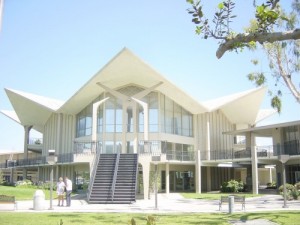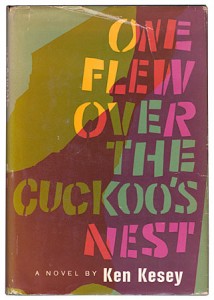The word in academic circles is that the CSUF is busted. Or at least it doesn’t have the wherewithal to swing a deal under consideration to buy back property it once owned across Nutwood Avenue.
The site is the current home of Hope University and it contains some wonderful buildings designed and constructed as part of a modernist master plan. The rough idea was that the CSUF Auxiliary would acquire the property, and, after a lease-back period to Hope, would start knocking everything down – presumably to throw up more out-of-scale, hideous erections. We first wrote about it here. And our expert consultant defined the term “exaggerated modern” here.
So the recession may have a silver lining anyway – at least as far as historic preservation is concerned, but we shall see what the future brings.
In the meantime, just to the south, the giant hole in the cityscape left by the demolition of perfectly fine modern-style buildings to make way for the Jefferson Commons swindle are a silent yet eloquent testimonial to the lack of foresight exercised by our elected leaders.
Dear Friends, we have just received this poem from a life-long Fullerton resident who goes by the web-handle of “Bushido Poet.” Apparently BP is a ninth-level haiku master. So when he haikus, we listen:
Rain patters my roof
Cold winds rattle the window
A braying donkey
Last Saturday the hubby and I dropped in on the Maverick Theater to see their production of “One Flew Over the Cuckoo’s Nest,” a theatrical adaptation of Ken Kesey’s novel.
Now I’m not much of a theater goer, I had never been to a local Fullerton production, and I have never written a critique of a stage production, so I apologize ahead of time, and you can take this review for what it’s worth.
The Maverick Theater is in the back of a pretty unprepossessing industrial/warehouse building at 110 East Walnut Avenue, and you’ve got to give the Maverick folks a lot of credit – the single scene stage is about the size of my living room, and requires a deft choreography by the director and the cast. The venue lends itself to an extremely intimate relation between performers and the audience – the sort of proximity that lends itself to close study of the actors – for good or ill.
The story itself is the (pretty well known) dark comedy about the battle of wills between the conman Randall P. McMurphy, who has gotten himself committed to avoid a jail work detail, and the control freak-spinster-evil bitch-monster, Nurse Rached, who plays the nuts in the mental ward off each other for her own perverse satisfaction.
The leads are engaging actors; both Brennan Thomas as McMurphy and Julie Patzer as Nurse Rached were able to capture and hold audience attention, although Brennan’s choice of a Southern-sounding accent was a strange affectation in a story that takes place in the Pacific Northwest. I got the strong impression that a lot of Paul Newman in Cool Hand Luke had been injected into the performance, particularly in the scene in which McMurphy chastises his fellows for feeding off of him. Still, Thomas’ rollicking performance was satisfactorily charming and ribald.
The part of Chief Bromden, the Indian narrator in the Kesey book, was played by Enrique Munoz. It seemed like one of the toughest roles in the play, and Munoz essayed it with energy, but ultimately in what I thought was an overly hand-wringing and lachrymal manner that seems to miss something of the Native American character: the overtly disturbed and wounded-child of Bromden’s introspective monologues didn’t seem to translate well into the outward character’s relationship with McMurphy in the Second Act.
The performances of the supporting actors was uneven. David Chorley did a wonderful job portraying the shy and stuttering Billy Babbit; Scott Keister as Frank Scanlon, pulled off an uncanny rendition of Christopher Lloyd’s character “Taber” in the film version. But some of the other parts were performed somewhat awkwardly or overly mannered. The ward attendants just didn’t seem to be able to get into the comic spirit of their parts while the sexually conflicted Dale Harding, as played by Stan Morrow, seemed too much like an over-the-top homosexual caricature.
Although it seemed a bit long, the productions was pretty entertaining and is worth seeing. I’m glad we went. The show runs through February 21.
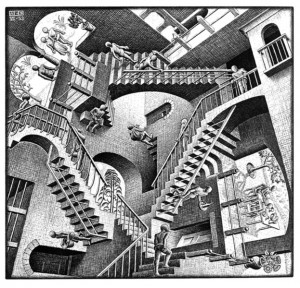
Using computers to arrange and sort data is useful for all sorts of things – especially when in comes to creating three dimensional imagery. Nobody can deny the impact of presenting scanned data for medical diagnostic purposes; or the use of scaled multi-disciplinary construction models that can simulate a 3D environment: very useful for ascertaining “clashes” between different trades as well as presenting the architect and client with views of his proposed effort.
But despite the technology drum beater’s boosterism (think laptops for kids, FSD style) there reaches a point in every computer application where the information is either too dense or voluminous to be assimilated or analyzed by those looking at it; or is just plain non-effective compared to traditional approaches; or worst, lends itself to misinterpretation or deliberate misrepresentation. This point of diminishing returns is reached quickest when the recipients of data just don’t know what to do with it. When that occurs they’re bound to do something bad with it.
Such may very well be the case with a City of Fullerton program that promises to create a three dimensional model of downtown Fullerton. We received an e-mail the other day from Al Zelinka, who works for the Planning Department. We point out that Mr. Zelinka is very careful to explain that the pilot program is being paid for by SCAG, not the City (where SCAG got the money is obviously not a point of interest for Mr. Zelinka, or, presumably, us).
First, we are inevitably forced to ask why. Who will benefit from the necessary resources plowed into such a program? It’s hard to answer. And who will be able to use the information? We can envisage all sorts of staff (and consultant) time going into creating maintaining and manipulating such data; and then the inevitable jargon and rhetoric tossed back to the public to foist staff driven projects onto the public. The Council: aha! See? The 3D model supports (fill in the name of the Redevelopment Agency’s favored project).
Perhaps the most important question is whether, once the model is done, it needs to be tended and updated by the City. If not, the effort going into seems to be something of a waste.
In any case the public are invited to a meeting on December 16th @ 6 PM in the Council Chambers to see the wonders of 3D modeling. No doubt all of our questions will be answered with sparkling clarity.
At the bottom of his e-mail Mr. Zelinka (AICP) includes a quotation that ought to give pause to even the biggest Planning Department cheerleader:
“Dedicated to Making a Difference.”
“Make no little plans. They have no magic to stir [women’s and] men’s blood….” – Daniel Burnham
Ay, ay, ay!
Oops. “Community Colleges.” Oops. I mean “Colleges.”
It was the best of times, it was the worst of times…
A while back we spent some time looking at the architectural monstrosities being foisted on students and bond underwriters (us) at Fullerton Junior College. We noted the crappy fake historical detailing, the blocky bulk of the overbearing McSpanish dinosaurs, and of course we regretted the intellectual confusion that equates fake old with real old and believes building crappy architecture enhances historical buildings.
Here’s a reminder of what we were talking about.
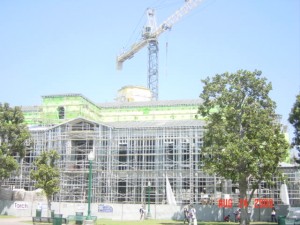
Ye gods! A series of out-of-scale, fake-arched, hollow-walled, Styrofoam-corniced, bulk-squatting godzillas dumped across the campus.
We also lamented the fact that in lower-middlebrow land nobody seemed capable of conceiving the deployment of inventive and engaging contemporary architecture.
In response to a follow up post this fall, a Friend forwarded images of some recent buildings that have gone up at Santa Monica (Junior) College. We share them below.
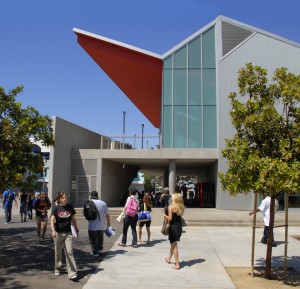
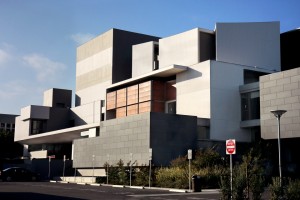


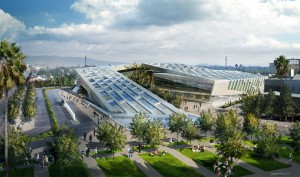
Hmm. Food for thought. Okay, the west side of LA, SM, and Culver City are chock-full of talented architects and designers of the SCI-Arc variety, and north Orange County is chock full of…well, let’s let that one go for now.
What’s baffling is that there doesn’t seem to be anybody on the NOCCCD staff or board with a clue. Instead of doing new buildings that actually stimulate aesthetic interest, they prefer to cough up the dreary, banal, and embarrassing visual tripe of McSpanish. And then threy dredge up support for their travesties from equally clueless citizenry.
Time for a change?
We’ve made a pretty big deal on this blog about the use of brick veneer, specifically, the way our Redevelopment Agency has always insisted on slathering it on to stuff to try to give the false appearance of historic structure, or under the guise of matching what is supposed to be the building material par excellence of downtown Fullerton: red brick.
We thought it was about time to get an historical perspective on the uses of architectural veneer – particularly masonry veneer, and so we have once again called upon the good offices of Dr. Ralph E. Haldemann, Professor or Art History (Emeritus) at Otterbein College, and our adjunct Arts and Architecture Editor. Doc?

The question of the role of veneers in architectural history is really quite fascinating, but requires an amount (admittedly minimal) of erudition. I will try to sum up some thoughts on the subject.
In pre-modern times the nature of building materials basically necessitated that structural materials were de facto finished materials as well – although historical exceptions are not uncommon: we know of course, that the Romans during the Imperial Era were fond of using stone veneers on brick buildings to dress them up. Such uses of marble veneer were often used in the Western Mediterranean basin countries in Romanesque and Italian/Venetian Gothic buildings.
The use of plaster cement or lime-based coatings on brick, especially non-fired brick, has an ancient lineage that reaches forward into the adobe buildings of California’s own Mission period; however neither this application nor the modern use of lath and plaster on studs can be considered a veneer.
Medieval Europe, particularly in the non-deforested climes of the north, saw a rise in timber construction in which the structural members were exposed and the interstitial areas filled with plastered wattling. Again, such fill even though non-structural, cannot rightly be called a veneer.
With the advent of structural iron and steel, fill materials in modern commercial architecture remained brick (for practical and fireproofing reasons). However, terra cotta facings with ceramic finishes attached to the underlying structure became the norm from the 1890s through the 1920s; the wide adoption of moderne styles in the 20s and 30s often replaced highly detailed terra cotta with simpler and smoother concrete and even ceramic tile finishes. These uses generally applied a finished masonry surface over an unfinished substrate of common brick. These are veneers.
It was really in American domestic architecture that brick veneers (almost exclusively brick) captured the imagination of a growing bourgeois sensibility. After the industrial age had ushered in standardized lumber, machine made nails and mass produced balloon-frame wood houses, a longing for the perceived hominess and historicity of brick set in. This was aided by several cultural American Colonial Revivals, particularly in the early 20th Century that coincided nicely with eras of vast suburban expansion. It was all mostly a real eastate come-on.
The use of phony brick surfaces continued unabated in the little cracker box houses of the ’50s and persists happily to this very day, particularly in subdivisions where an emotional attachment to American historical antecedents is being peddled.
The use of fake brick fronts in commercial areas followed the same suburban trajectory as the use of the material in domiciles. It too persits today, particularly where city fathers and chambers of commerce wish to deal out a conjured up historical image for their otherwise unremarkable and humble burgs.
Modern architectural theory held that this sort of use of non-structural masonry veneer is fundamentally non-truthful, meretricious and basically a middlebrow (or lower) affectation. And so it is! And yet the Robert Venturi school of Post-Modernists embraced such use for its exuberance, color and tactile properties, as well as potential (often ironical) historical connotations. However it must be said that when the historical connotation is wrong, or the deployment is meant to be deceptive or even slavish, a real aestheic problem exists; and can, if left uncontrolled, lead to real civic embarrassment.
Ralph E. Haldemann, Ph.D.

